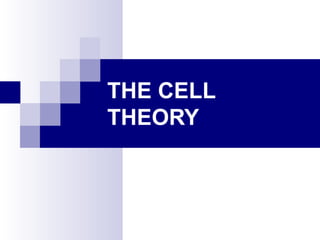More Related Content Similar to Ch.1 the cell (theory) Similar to Ch.1 the cell (theory) (20) More from CDA-PamelaOrtiz More from CDA-PamelaOrtiz (20) 2. What level of complexity is
necessary for life?
Aristotle (384 – 322BC)
Unorganised
material
(non-living) Homogeneous
Matter (tissues)
Organised
material (living)
Heterogeneous
(organs)
© 2010 Paul Billiet ODWS
4. What level of complexity is
necessary for life?
C17th microscopists discovered tissues
were made of cells (Hooke 1665 and
Leeuwenhoek 1677)
Image Credit Cork cells
© 2010 Paul Billiet ODWS
5. Cells
C18th and C19th
showed that
tissues were
made of cells
The cells of a
particular tissue
had a common
structure. Image Credit Liver cells
6. What is a cell?
Taken to its simplest form
A plasma membrane…
Surrounding cytoplasm…
Containing hereditary material.
© 2010 Paul Billiet ODWS
7. What level of complexity is
necessary for life?
Xavier Bichat Organism
(1771-1802): An organ
is composed of different Organ-system
tissues
Several organs can be
Organ
grouped together as an
organ system (e.g. the Tissue
digestive system)
An idea of hierarchy of Cell
structure developed:
© 2010 Paul Billiet ODWS
8. What level of complexity is
necessary for life?
Purkinje (1835) Observed a fertilised hen's
egg (a single cell) could develop into an
embryo (many specialised cells in a
compact mass)
C19th botanists showed that plant tissues
consist of many different types of cells.
© 2010 Paul Billiet ODWS
9. THE CELL THEORY
Matthias Schleiden (1838) & Theodor
Schwann (1839)
“The cell is the basic unit of living
tissue”
The cell is an autonomous unit (“a citizen”)
grouped together to form an organism
(“the society”).
© 2010 Paul Billiet ODWS
11. THE ORGANISMAL THEORY
The counter arguments:
Reichert a morphologist: Argued that an
organism has a structured plan
Image Credit Frog embryo Image Credit Frog embryo fate map
15. Unicellular organisms
Some organisms only consist of a single
cell
But these do usually have the components
of cells (nucleus, membrane etc)
Image Credit Paramecium
16. Cellular components
Some cells lack the basic components
But as a result their functions are affected.
Image Credit Red blood cells
17. Tissue culture
Cells can be cultured away from a body
But this often requires elaborate support
systems
Image Credit Tissue culture hood U of Wisconsin
18. SUMMARY
THE CELL THEORY THE ORGANISMAL
THEORY
1. Multicellular organisms develop 1. Some organisms are not divided
from a single fertilised germ cell (the into cellular compartments
zygote) = non-cellular
2. The basic components of the cell 2. Certain cells lack the basic
are repeated in every cell components
Cells in multicellular organisms are
highly specialised
Unicellular organisms have a
cytoplasm that is not subdivided
Should be considered as acellular
© 2010 Paul Billiet ODWS
19. SUMMARY
THE CELL THEORY THE ORGANISMAL
THEORY
3. All cells come from cells 3. Remove cells from complete
multicellular organisms requires
Cells can be taken from organisms elaborate life support systems to keep
and cultured away from the body them alive
New individuals can be cultured from
isolated cells
Regeneration capacity = totipotence
4. Homeostatic control and co-
ordination is required to maintain the
whole organism whether it is
unicellular or multicellular.
© 2010 Paul Billiet ODWS
20. Cell theory or organismal
theory?
That the cell is the basic unit of living
organisms is accepted
That unicellular organisms carry out all the
functions of life is accepted
BUT multicellular organisms are not
simply a mass of similar building blocks
© 2010 Paul Billiet ODWS
21. More is different!
As a multicellular organism grows and
develops it follows a structured plan
The cells specialise (differentiate)
The whole organism shows homeostatic
control
A developing multicellular organism shows
emergent properties
It is not just the sum of the parts
© 2010 Paul Billiet ODWS
